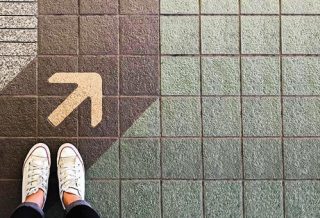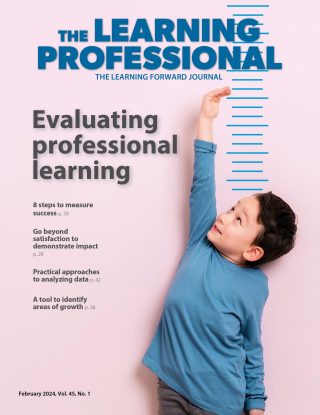FOCUS
Students as education partners
By Emanuelle Sippy and Rachel Belin
Categories: Continuous improvement, DataFebruary 2020
Vol 41, No. 1
From the Little Rock Nine and the Children’s Crusaders during the civil rights movement to today’s Dreamers and organizers of the March for Our Lives, young people have long been on the front lines of pushing for systemic change. The Prichard Committee Student Voice Team, consisting of 100 self-selected students from across Kentucky, works in that tradition to improve schools and society.
The Student Voice Team is an extension of the Prichard Committee for Academic Excellence, an organization that has been mobilizing citizens to improve education in Kentucky for nearly 40 years.
At its core, we believe that students can bring enormous added value in making schools better. We also believe that, along with teachers, young people on the front lines of our classrooms are in the best position to help bridge education policy and practice.
Do you know the distinction between meaningful student voice and nonmeaningful student voice? #LearnFwdTLP #StuVoice Click To TweetFor our team, student voice is about recognizing that students are the primary stakeholders of their education and creating space for them to have agency in addressing significant issues that affect them, their schools, and their communities. We distinguish meaningful student voice — students framing issues, co-designing and helping to implement solutions — from nonmeaningful student voice, which has students serving in more superficial or symbolic roles like sitting on a panel with a predetermined agenda.
We see teacher and student voice not as competing interests but as mutual ones. Our work is radical not because it is by youth and for youth, but because it is intergenerational. We believe that students and teachers can learn with one another about how to improve schools in ways that are ongoing and meaningful.
.@emanuellesippy and @rbelin99 discuss in their #LearnFwdTLP article how they see teacher and student voice not as competing interests but as mutual ones. @PCStuVoiceTeam #StuVoice Click To TweetSCHOOL CLIMATE AND SAFETY
The need for student voice in school policy conversations is especially pronounced in the context of real-world issues that affect our schools and communities. The spate of school shootings and the national conversation about how to deal with school violence offer a prime example.
Like students across the country, the Student Voice Team has been shaken by the trend of school shootings, including one that occurred in Marshall County, Kentucky, just weeks before the widely reported shooting at Marjory Stoneman Douglas High School in Florida. But all the talk that followed about securing schools with metal detectors and armed teachers didn’t resonate with us. We knew the conversation about solutions should transcend school shootings and be part of conversations we were already having about students’ connections to their schools and with each other.
As we were talking with students about their school communities and the issues that mattered most to them, we came upon some of the work of the National School Climate Center, which defines school climate as the quality and character of school life — that is, whether people feel physically, socially, and emotionally safe, included, and engaged in school. School climate involves myriad elements, including a school’s norms and values and relationships between students and staff and among students.
The center’s decades of academic research support the fact that a positive school climate directly correlates with better academic achievement, as young people who feel safe, included, and engaged in school tend to be much more motivated to do well in class. As if that weren’t enough, we learned, attention to school climate is a matter of educational equity because a positive or negative school climate can have a disproportionately profound effect on minority students, students from low-income families, English learners, and students with special needs.
Yet, even when schools aim to build teachers’ knowledge about cultivating positive school environments, they often fail to include student perspectives. We realized we could bring added value and influence to conversations about school climate and efforts to improve it. We had routinely engaged students and educators in conversations about students’ roles in school governance and exploring ways for students to have more voice and agency, but school climate allowed us to focus our work.
This work is about much more than school violence, but the research we have reviewed tells us that there is a link — and that students have an important role to play in advocating for safer and healthier school climates and building knowledge about how to create them.
STUDENT-LED AUDIT
Schools can’t improve if they don’t know where they are starting. With a grant from a local community foundation, we created a prototype of a student-led school climate audit so everyone in the school community can become informed and take action.
We knew students had been asked to participate in such audits before, but we were puzzled by the fact that they were never privy to the results. We wanted to test a model in which students themselves led the way, to ensure that the primary stakeholders would have a better understanding of the extent to which their school is a safe, supportive, and engaging place to learn.
In our approach, students facilitate focus groups and interviews, conduct site visits and classroom observations, and analyze school climate surveys. The data they collect can be acted on by students and teachers alike, learning and working together.
Just a few years into our venture, and with some generous guidance on survey design from Panorama Education, we’ve been gleaning a lot. One common theme we noticed right from the beginning is that it appears far too many high school students are feeling disconnected from school. Of the 1,552 students we surveyed in our first research cohort of three geographically diverse schools, only about a third reported feeling valued in school and invested in what they’re learning.
Sometimes the results seem paradoxical. At one school, for example, 34% of students reported that their peers’ behavior hindered their learning, yet 57% said they thought the rules for school were unfair. At another school, 30% admitted feeling “slightly” or “not at all eager” to participate in class, yet 85% believed it was important to do well in school.
Focus groups in these initial studies further illuminated the numbers. At one school, a student confided, “I feel like I don’t have a place I can go to and have people with personal experience and understanding about what it feels like to be a black Latina in a school full of white students.”
We also got some decidedly hopeful feedback, especially as many of the students we interviewed affirmed the value of their relationships with teachers. “I think all of my teachers, whenever I’m having a really bad day, they can notice,” one student observed. At a minimum, the results serve as fodder for richer, more reflective conversation about whether and how our schools are serving all learners.
MAKING CHANGE
Central to our student-led school climate audit model is a share-back session in which students design and facilitate dialogue in their school communities to make sense of the findings and cultivate solutions. In our experience, this kind of dialogue is rare in adult-led audits.
What does it look like when students design and facilitate dialogue in their school communities? #LearnFwdTLP Click To TweetTo do this, we have developed a simple infographic-heavy report format that integrates quantitative and qualitative data, and we ask students and staff to dig into it. We facilitate a conversation with open-ended questions like:
- What does this report suggest to you about this school?
- What else would you want to know about this school based on what you see?
- Who seems to be benefiting most and least from this school’s climate, and why do you think this is?
- What can and should we do with this information to make this school a better learning environment for more people?
Our model is gaining traction across the state, prompting another major innovation to address the challenge of scale. Instead of Student Voice Team members conducting the audits as independent agents, we have been working with districts to train and support students to lead climate audits in their own schools. The effort involves the design and testing of an open-source curriculum students and teachers can use to ensure a level of quality in their auditing and learn from some of our team’s best mistakes. In these schools, students become leaders from whom teachers can learn.
MOVING THE PUBLIC POLICY NEEDLE
Several years into the prototyping, our grassroots school climate audits are starting to have an impact on larger public conversations and public policy.
In the context of the growing outcry over school shootings, our team held a teach-in and rally on the Kentucky Capitol steps, which drew a wide intergenerational audience from across the state. We drew on student feedback from the audits as well as academic research to make our case and shape the narrative that attention to school climate and social and emotional well-being are essential to making schools safer. We also shared testimony before the Federal School Safety Commission using similar language.
We even used data from the audits to weigh in when a local property tax bill came up for consideration, urging the public to take an approach to school safety that lent itself to a broader discussion about school climate. This groundwork led to a legislative victory when our team was asked to place a student on the School Safety Working Group, which was charged with developing the bipartisan framework for addressing Kentucky’s safety concerns.
Our representative — a high school junior who had participated in a number of our independent audits — worked side-by-side with legislators, drawing on data from the schools we audited and inviting other students to testify before the committee. The result was the School Safety and Resiliency Act, which passed its final reading after adopting an amendment that was a behind-the-scenes nod to our work: a stipulation that students are represented as required school safety plans are developed.
Additional, powerful examples of young people shaping important public conversations in Kentucky include:
A group of our members at one high school concerned about the rollout of metal detectors and security officers there surveyed 600 peers to ascertain the impact of the new measures. The results showed that, while a majority felt that the measures made them physically safer, a distinct minority said they prompted new fears and created a prison-like atmosphere. The team then shared the data with teachers and administrators to prompt a larger discussion about the need to focus on more alienated students.
After leading a study to measure the extent of sexual harassment in high school, a member of our team formed a nonprofit dedicated to sexual harassment education. The results were picked up by the local and national press, and she is now developing materials to train students to address the problem in their schools.
Other members of our team conducted a study about mental health stigmatization in schools and founded a nonprofit dedicated to mobilizing students to educate peers on a range of mental health issues. The group works with mental health professionals and hosts an annual summit for students from throughout the state.
And yet another member affiliated with our team is embarking on a second year of coordinating a statewide, bipartisan campaign to ban corporal punishment in the 17 Kentucky school districts that still practice it.
Our team members also serve as informed spokespeople for scores of news media covering school safety, and we have published several op-eds in all of the state’s major newspapers.
LEARNING TOGETHER
In just a few short years, between attending classes, taking tests, doing homework, and everything else being full-time students entails, our team has had an outsized impact beyond the classroom. Between them, members have generated 60 op-eds, led 165 local and national presentations, produced three policy reports, organized three statewide capitol rallies, created a blog and a podcast, and even published a book.
Our entire process is a shift in power. It positions educators and students to not only learn together from gathering and interpreting data but also collaborate to enact and assess solutions. We ask educators to remember that students are capable of much more than planning dances and bake sales. Rather than asking for student opinions after decisions have been made, we implore educators to consult students from the beginning.
Learn how you can support students to do democracy in addition to them studying it. #LearnFwdTLP Click To TweetWe know it’s easier said than done, but it can be done. Enlisting students as education improvement partners at the school, district, and state levels engages students in the civic life of schools and communities. It demonstrates what it can look like when we support students to do democracy in addition to studying it.
Enlisting students as education improvement partners at the school, district, and state levels engages students in the civic life of schools and communities. #LearnFwdTLP Click To TweetAbout the student voice team
The Student Voice Team includes 100 students from across the state of Kentucky, but we don’t speak just for ourselves. Elevating meaningful student voice demands making space for all students to have a role in decision-making, not just a selected few. We are focused on equity, so one of the most important questions we continually ask ourselves and others to consider is: What obligation do I have to students in my world who may be least heard in it?
Because our self-selection process tends to draw students who are successful in school, we know our members cannot represent fully the Kentucky student experience. To do so, we reach out to other students from all backgrounds primarily in the form of student-to-student interviews and roundtables.
We are also intentional about amplifying the voices of students who are least heard by sharing their stories on a range of platforms from social media and blogging to op-eds, policy reports, professional learning, and speaking engagements. We aim not to tell the stories of students for them but to encourage them to tell their own, whether we’re talking with a handful of African American students about race in a predominantly white, rural school; visiting students at a school for the deaf to talk about the challenges of communicating with teachers who are not native sign language speakers; or listening to students in one of the most underresourced school districts speak to their experience of limited extracurricular opportunities.
Categories: Continuous improvement, Data
Recent Issues
TAKING THE NEXT STEP
December 2023
Professional learning can open up new roles and challenges and help...
REACHING ALL LEARNERS
October 2023
Both special education and general education teachers need support to help...
THE TIME DILEMMA
August 2023
Prioritizing professional learning time is an investment in educators and...
ACCELERATING LEARNING
June 2023
Acceleration aims to ensure all students overcome learning gaps to do...












